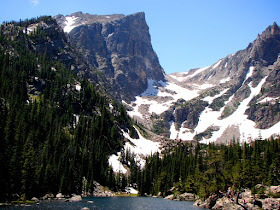In the last post, we saw Rocky Mountain National Park turn black, white, and shades of gray during an intense thunderstorm. It was another day on our vagabonding journey across the 39th parallel, a trip that explored the geology across Nevada, Utah and Colorado last July. I've been expounding on our discoveries off and on ever since. We managed to score a campsite for a second night in Rocky Mountain National Park, which gave us time for a short hike into the realm of the glaciers.
Our campsite the first night was in a rocky gorge just downstream of the glacial terminus in Fall River Valley at Aspenglen. The previous day we had experienced a bit of magic on a walk around Bear Lake, one of the most popular stops in the park, and we decided we wanted to explore a bit higher, closer to the origins of the glaciers that once existed in the park.
The short hike to Nymph and Dream Lakes looked like it would do the trick. It shared a trailhead with Bear Lake, but climbed a few hundred feet in a mile to a pair of tarns, rocky basins scoured out by glaciers during the Pleistocene Ice Ages. It didn't take long to arrive at the lily-filled Nymph Lake.
An entire corner of the lake was covered with some kind of water-loving flower with strange stringy petals, whose identity I leave to you, the reader. This is because I am a geologist, who despite knowing hundreds of mineral and rock names, cannot remember the names of more than a dozen flowers or so...
The skyline above the lake was dominated by the tower of Hallett Peak (12,713 feet; 3875 meters), a reasonable example of an almost-horn. A glacial horn is a spiky kind of mountain peak that is surrounded by cliffs caused when glaciers plucked away at the base of the mountain. The Matterhorn in Italy/Switzerland is a famous example. Hallett Peak has indeed been plucked, but a considerable area of the original unglaciated surface still remains on the highest part of the mountain.
From Dream Lake a little higher up the trail, the profile of Hallett was clearer. One can see the u-shaped valley to the right of the peak. Rivers only erode the bottom of a valley, and mass wasting adjusts the valley walls into an V-shape. Glaciers scour the valley walls and the valley bottom, giving the valley a more circular aspect.
I was entranced by another flower (yellow this time; identification welcome!) along the trail.
Walking down the trail, I was more aware of the sweeping view we had to the south towards Longs Peak (14,259 feet; 4346 meters), the highest peak in the park. Glaciers actually had a challenge with the rocks of Rocky Mountain National Park. They consist mainly of hard granite and metamorphic rocks of Proterozoic eon, mostly between 1.7 and 1.4 billion years. The glaciers repeatedly tore away at these rocks during a series of glaciations starting about 2 million years ago and ending only about 13,000 years ago. There is clear evidence of three episodes, but independent climate records (on the ocean floor, for instance) suggest there were many more. A mere handful of glaciers remain, covering only a few acres.
We hiked back down the trail and saw the storm clouds gathering again. We were starting to appreciate just how sunny our hike had been as a second huge thunderstorm enveloped the region. This one was actually more fierce than our storm the previous day, and lasted for hours. We found that our tent had a slight vulnerability to heavy rain, and we watched helplessly as the tent filled with water. Finally, around midnight the storm let up (we had retreated to the car), so I grabbed a towel and cleaned things up as much as I could. In the morning we discovered that our campsite had a stunning view of Longs Peak that we couldn't have seen during the storm of the previous night. Strange lenticular clouds drifted around the summit of the mountain in the early morning.
It was time to cross the Continental Divide and start our homeward journey...in the next post we tackle the Trail Ridge Road.










White first vegetation-specimen is the Bogbean Menyanthes trifoliata
ReplyDeleteThe Rockies were the first mountains to capture my heart as a very young person and now I haven't been back in way too long. Thanks for sharing.
ReplyDeleteWhile in college, I spent a summer working at the YMCA of the Rockies, in Estes Park. The Y adjoined the Rocky Mountain National Park, and I spent all my days off exploring the area.
ReplyDeleteYour pictures bring back a lot of memories! Thank you!
The yellow flower is one of the golden beans, Thermopsis sp. I know it well, as I was poisoned by it when I was a toddler!
ReplyDelete--Howard
Great post. I've spent a lot of time hiking in and around Colorado and this makes me yearn to be back in the mountains.
ReplyDeleteDani @ ONNO Organic Clothing